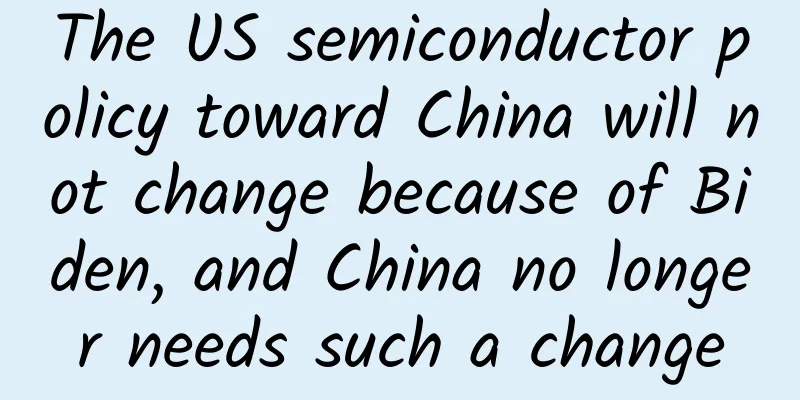The US semiconductor policy toward China will not change because of Biden, and China no longer needs such a change

|
The U.S. presidential election has dominated China’s major social media platforms. This US election is the one that Chinese people have watched the most in recent decades. In addition to the various farces performed by "King of Understanding", the most important factor is that many Chinese people believe that the Biden administration's China policy will change, such as the control over the semiconductor industry. But will things really go according to this script? The strategic importance of semiconductors In the past two years, the Sino-US trade war has involved culture, economy, policy and other aspects, but the semiconductor industry is undoubtedly at the center of the controversy. In 2018 and 2019, for two consecutive years, the Trump administration imposed tough policy restrictions on Huawei in an attempt to put China's advanced semiconductor business to death. Trump's overreaction actually shows the importance of the semiconductor industry to the United States or to the world. As we all know, semiconductors have brought about global technological breakthroughs and driven economic growth. Since the 1990s, semiconductors have been a key factor in driving the continued growth of the global economy. The reason why we can use smartphones today is mainly due to the large-scale computer experiments led by the United States in the 1980s. In just three decades, the number of transistors in smartphone chips has increased by nearly 1 million times compared to mainframes, and the processing power has increased by 450,000 times. This is the underlying power behind smartphones that are popular all over the world. In the foreseeable future, we will enter the AI era of digital transformation. Whether it is AR, self-driving cars or Industry 4.0, the operation of this world is inseparable from the iteration and update of the semiconductor industry. Correspondingly, technological breakthroughs in the semiconductor industry have become the most powerful engine for economic growth. The Semiconductor Industry Association said that global semiconductor industry sales are expected to reach $433 billion in 2020 and will further increase to $460 billion in 2021. This is also the main reason why the United States, which has an advantage in semiconductor technology, has outperformed other high-income countries in productivity and GDP growth since 1988. In addition, semiconductors have also built the US military hegemony. Although the semiconductor industry is currently mainly used in the C-end, the industry was mainly cultivated by the military. Between 1948 and 1957, 38% of the $22.3 million in transistor research costs at Bell Labs was contributed by the US Department of Defense, and in the mid-1950s, this proportion reached 50%. To date, high-tech electronic components still play a leading role in defense technology products such as missiles, aircraft carriers, and anti-reconnaissance. The 2018 U.S. National Defense Strategy has made the microelectronics industry a key focus of defense modernization. Mike Griffin, the U.S. Deputy Secretary of Defense for Research and Engineering, bluntly stated that "technological advantages such as semiconductors are the key to winning future conflicts." Mike Griffin America's Core Competitiveness Semiconductors are so strategically important. On the one hand, the United States is desperately trying to maintain its technological advantage over the past few decades, and on the other hand, developing countries also hope to seize this technological high ground. When these two trends collide, friction is inevitable. Since 2000, the Chinese government has been gradually planning a breakthrough in the semiconductor industry by developing the national semiconductor industry and reducing dependence on foreign suppliers. Data released by the China Semiconductor Industry Association shows that since 2015, the total revenue of semiconductor companies operating in China has increased by more than 20% per year. If nothing unexpected happens, it is estimated that by 2025, China's domestic semiconductor suppliers will meet more than 70% of the country's semiconductor demand. But as we expected, the unexpected happened. In the face of the rising tide of China's semiconductor industry, the Trump administration, on the one hand, implemented a "disengagement" policy at the manufacturing level to get rid of dependence on China, and on the other hand, exerted policy-level pressure on the industrial chain in an attempt to stifle the development of China's semiconductor industry. Judging from the early publicity, the Biden administration is more moderate in its China policy than the Trump administration, but as economist Evernet said: "Protectionism has a long tradition in the United States. No matter who the next president is, he will follow national interests in trade policy like all his predecessors. Trump is just the one with the louder voice between the two." A careful analysis of Biden's policies reveals that although Biden has loosened up on peripheral manufacturing, he still said that "they will gradually return" to key industrial chains such as semiconductors and medical care. In fact, as the president of the United States, both Trump and Biden have the responsibility to maintain the United States' technological leadership. The debate between Trump and Biden on core issues is just two sides of the same strategy. The American gamble in the semiconductor industry Although the United States has certain strategic advantages in this war over semiconductors, this does not mean that China is in a completely passive position. This is mainly because the US policy itself is a gamble. The Peterson Institute for International Economics published a report titled "How Trump's export restrictions on semiconductors and equipment hurt the U.S. technology industry" stating that the Trump administration's export control policies have severely damaged the domestic semiconductor industry in the United States and may eventually lead to other countries no longer relying on U.S. technology. At a time when the semiconductor industry in the United States was relocating on a large scale, a sudden COVID-19 outbreak occurred. Deborah Birx, coordinator of the White House COVID-19 response team, said that the US epidemic has reached the "most worrying and deadly" moment. American technology companies including Google and Amazon were forced to announce "work from home". However, the semiconductor industry is a high-density labor industry, and it is impossible to "make chips at home". Therefore, this "accident" may have a profound impact on the development of the US semiconductor industry. Contrary to the Trump administration’s “closed-door” policy, China’s semiconductor industry has found an independent and self-reliant development path driven by both demand and policy. In the past two years, China's Ministry of Finance, Ministry of Commerce, National Development and Reform Commission and other departments have frequently issued policies to support the development of the semiconductor industry. For example, the fiscal department has issued a tax reduction and exemption policy of "ten exemptions" and "five exemptions and five reductions by half". The "14th Five-Year Plan" also clearly lists integrated circuits as a major national scientific and technological project with a very strategic position. This favorable policy at the macro level has clearly provided a strong belief support for China's semiconductor industry. In terms of industry, many outstanding semiconductor companies have emerged in China in recent years. For example, HiSilicon, which is regarded as a thorn in the eyes of the United States, achieved revenue of US$2.4 billion in 2019, ranking first in Asia's IC design. Coincidentally, in 2019, the market share of China's semiconductor packaging and testing market reached 11.3%, ranking third in the world. In the field of semiconductor manufacturing, China's overall level is still some distance away from the world's first-class level, and is squeezed by the United States. However, considering that the growth path of semiconductor manufacturing is extremely single and requires a lot of high-quality time, capital and talents, with the dual encouragement of demand and policy, in the near future, China is very likely to achieve industrial upgrading along the established route. From the market perspective, the semiconductor industries of China and the United States have shown divergent trends. The International Semiconductor Industry Association said that due to the reduction in purchases from overseas customers, the US chip industry has lost nearly $170 billion; Professor Wei Shaojun, director of the Institute of Microelectronics at Tsinghua University and vice chairman of the China Semiconductor Industry Association, said that in the first half of 2020, 100% of the global semiconductor growth was contributed by China. In response to this trend, the Wall Street Journal wrote that China is expected to become the world's largest semiconductor production plant by 2030. This time coincides with the timeline of my country's "Manufacturing Power Plan". As a winner of Toutiao's Qingyun Plan and Baijiahao's Bai+ Plan, the 2019 Baidu Digital Author of the Year, the Baijiahao's Most Popular Author in the Technology Field, the 2019 Sogou Technology and Culture Author, and the 2021 Baijiahao Quarterly Influential Creator, he has won many awards, including the 2013 Sohu Best Industry Media Person, the 2015 China New Media Entrepreneurship Competition Beijing Third Place, the 2015 Guangmang Experience Award, the 2015 China New Media Entrepreneurship Competition Finals Third Place, and the 2018 Baidu Dynamic Annual Powerful Celebrity. |
Recommend
After studying dozens of popular apps, I will tell you how to design a good "Like" function
It is no exaggeration to say that "like"...
Fasting = stimulating cell autophagy, can it improve Alzheimer's disease?
Recently, Rong seems to like talking about food. ...
Are you also dominated by "battery health phobia"? Please click on the "correct way" to charge
In today's information age, computers and mob...
China Automobile Dealers Association: China's used car manager index was 43.8% in December 2021
On January 6, 2022, the China Automobile Dealers ...
2016 Christmas advertising video collection 1: Warmth makes winter no longer cold!
The annual Christmas is coming soon in this cold ...
A miracle in the history of science: the contribution of intuition goes beyond understanding
Faced with more than 60 known elements, all chemi...
From the market to policies, Chinese car consumers need hybrid technology with a "domestic brand"
What should new energy vehicles be like? Are they...
Hot selling product? 2 public traffic pools, 8 ways to divert traffic!
Do you believe it? Everything in the world will g...
WeChat Development Access Guide
Overview To access the WeChat public platform for...
iOS Tips: Disable the annoying app rating reminders in apps
Many app developers can't wait to remind user...
WeChat is updated again: We can now browse Moments on the computer
[[387098]] Today, when Shichao was browsing Weibo...
Product operation, why is the product user retention rate so low?
As the traffic dividend gradually disappears, it ...
Tik Tok movie editing tutorial, how to edit movie videos on Tik Tok?
Hello everyone, I am Teacher Achao. Today I will ...
IEA: Accelerating a fair transition in the coal industry
The International Energy Agency published “Accele...
WeChat official account adjustment: cancel the developer's customer service message sending quota in the payment scenario
On May 30, the WeChat public platform operation c...









